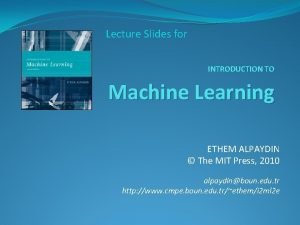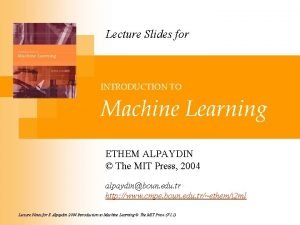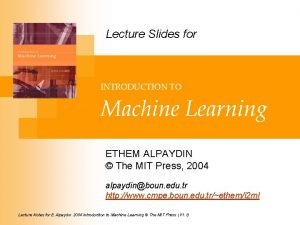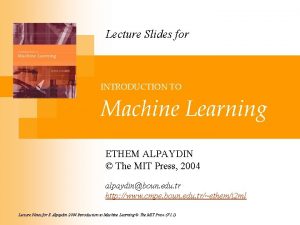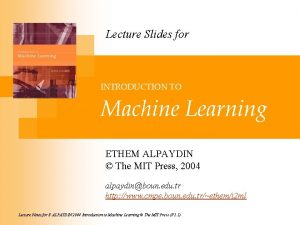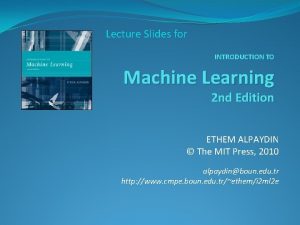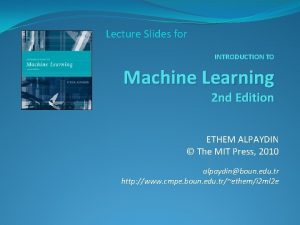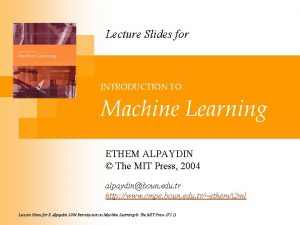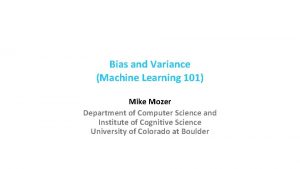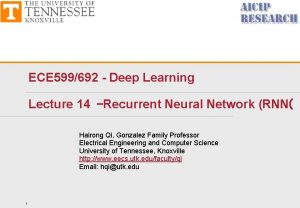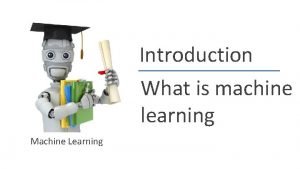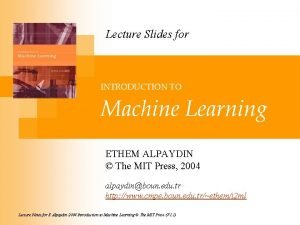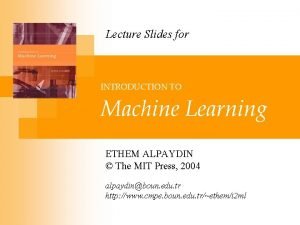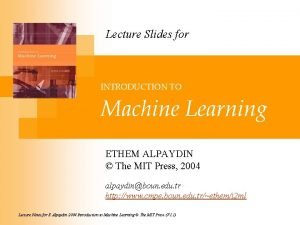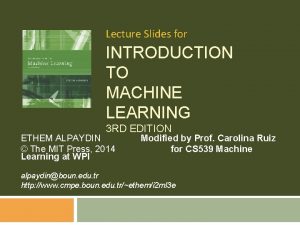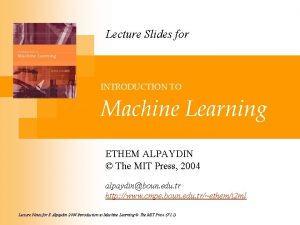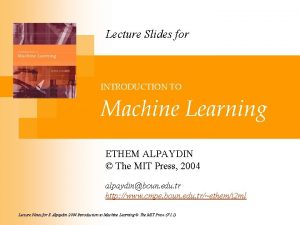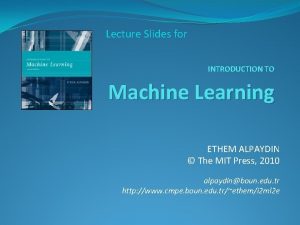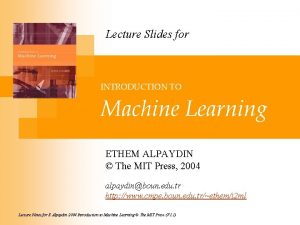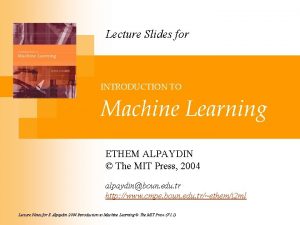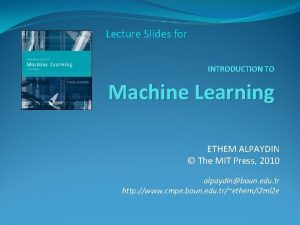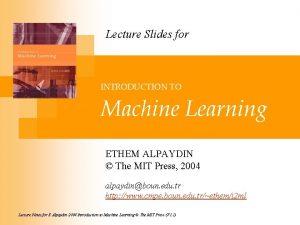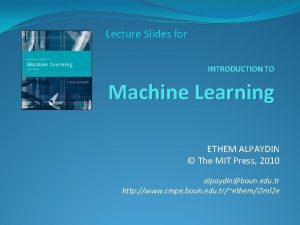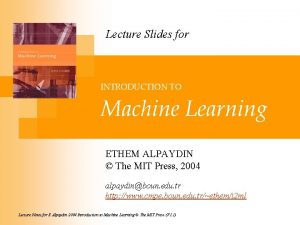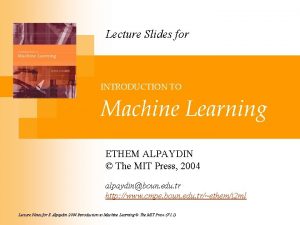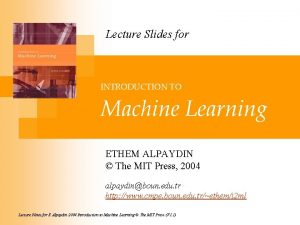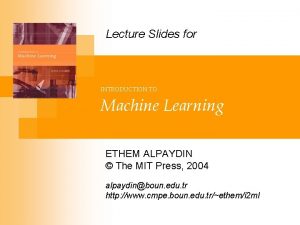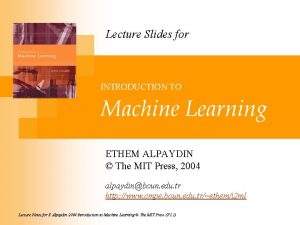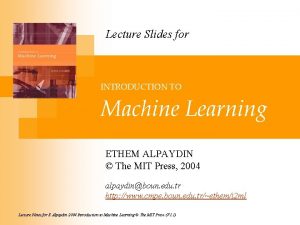Lecture Slides for INTRODUCTION TO Machine Learning ETHEM





































- Slides: 37

Lecture Slides for INTRODUCTION TO Machine Learning ETHEM ALPAYDIN © The MIT Press, 2004 alpaydin@boun. edu. tr http: //www. cmpe. boun. edu. tr/~ethem/i 2 ml

CHAPTER 11: Multilayer Perceptrons

Neural Networks of processing units (neurons) with connections (synapses) between them Large number of neurons: 1010 Large connectitivity: 105 Parallel processing Distributed computation/memory Robust to noise, failures 3

Understanding the Brain Levels of analysis (Marr, 1982) 1. Computational theory 2. Representation and algorithm 3. Hardware implementation Reverse engineering: From hardware to theory Parallel processing: SIMD vs MIMD Neural net: SIMD with modifiable local memory Learning: Update by training/experience 4

Perceptron (Rosenblatt, 1962) 5

What a Perceptron Does Regression: y=wx+w 0 Classification: y=1(wx+w 0>0) y w 0 y y s w 0 w w x x x 0=+1 6 w 0 x

K Outputs Classification: 7 Regression:

Training Online (instances seen one by one) vs batch (whole sample) learning: No need to store the whole sample Problem may change in time Wear and degradation in system components Stochastic gradient-descent: Update after a single pattern Generic update rule (LMS rule): 8

Training a Perceptron: Regression (Linear output): 9

Classification Single sigmoid output K>2 softmax outputs 10

Learning Boolean AND 11

XOR No w 0, w 1, w 2 satisfy: (Minsky and Papert, 1969) 12

Multilayer Perceptrons (Rumelhart et al. , 1986) 13

14 x 1 XOR x 2 = (x 1 AND ~x 2) OR (~x 1 AND x 2)

Backpropagation 15

Regression Backward Forward x 16

Regression with Multiple Outputs yi vih zh whj xj 17

18

19

whx+w 0 zh 20 v h zh

Two-Class Discrimination One sigmoid output yt for P(C 1|xt) and P(C 2|xt) ≡ 1 -yt 21

K>2 Classes 22

Multiple Hidden Layers MLP with one hidden layer is a universal approximator (Hornik et al. , 1989), but using multiple layers may lead to simpler networks 23

Improving Convergence Momentum Adaptive learning rate 24

Overfitting/Overtraining Number of weights: H (d+1)+(H+1)K 25

26

Structured MLP (Le Cun et al, 1989) 27

Weight Sharing 28

Hints (Abu-Mostafa, 1995) Invariance to translation, rotation, size Virtual examples Augmented error: E’=E+λh. Eh If x’ and x are the “same”: Eh=[g(x|θ)- g(x’|θ)]2 Approximation hint: 29

Tuning the Network Size Destructive Constructive Weight decay: Growing networks (Ash, 1989) 30 (Fahlman and Lebiere, 1989)

Bayesian Learning �Consider weights wi as random vars, prior p(wi) �Weight decay, ridge regression, regularization cost=data-misfit + λ complexity 31

Dimensionality Reduction 32

33

Learning Time Applications: Sequence recognition: Speech recognition Sequence reproduction: Time-series prediction Sequence association Network architectures Time-delay networks (Waibel et al. , 1989) Recurrent networks (Rumelhart et al. , 1986) 34

Time-Delay Neural Networks 35

Recurrent Networks 36

Unfolding in Time 37
 Ethem alpaydin
Ethem alpaydin Introduction to machine learning ethem alpaydin
Introduction to machine learning ethem alpaydin Machine learning course slides
Machine learning course slides Ethem alpaydin
Ethem alpaydin Machine learning ethem alpaydin
Machine learning ethem alpaydin Introduction to machine learning ethem
Introduction to machine learning ethem Introduction to machine learning slides
Introduction to machine learning slides Machine learning lecture notes
Machine learning lecture notes Ethem alpaydin
Ethem alpaydin A small child slides down the four frictionless slides
A small child slides down the four frictionless slides A crane lowers a girder into place
A crane lowers a girder into place Principles of economics powerpoint lecture slides
Principles of economics powerpoint lecture slides Business communication lecture slides
Business communication lecture slides 01:640:244 lecture notes - lecture 15: plat, idah, farad
01:640:244 lecture notes - lecture 15: plat, idah, farad Concept learning task in machine learning
Concept learning task in machine learning Analytical learning in machine learning
Analytical learning in machine learning Pac learning model in machine learning
Pac learning model in machine learning Pac learning model in machine learning
Pac learning model in machine learning Inductive vs analytical learning
Inductive vs analytical learning Inductive and analytical learning
Inductive and analytical learning Instance based learning in machine learning
Instance based learning in machine learning Inductive learning machine learning
Inductive learning machine learning First order rule learning in machine learning
First order rule learning in machine learning Eager classification versus lazy classification
Eager classification versus lazy classification Deep learning vs machine learning
Deep learning vs machine learning What is unsupervised learning algorithm
What is unsupervised learning algorithm Introduction to machine learning andrew ng
Introduction to machine learning andrew ng High bias low variance introduction to machine learning
High bias low variance introduction to machine learning Azure data mining
Azure data mining Lstm lecture
Lstm lecture Introduction to machine learning andrew ng
Introduction to machine learning andrew ng Cuadro comparativo e-learning y b-learning
Cuadro comparativo e-learning y b-learning Diyazem
Diyazem Ethem alpaydin
Ethem alpaydin Ethem alpaydin
Ethem alpaydin Ethem alpaydin
Ethem alpaydin Ethem alpaydin
Ethem alpaydin Ethem alpaydin
Ethem alpaydin
